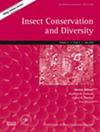Multiple facets of diversity reveal different patterns and processes in aquatic arthropod communities across the world's most extreme high-altitude treasure
IF 3.2
2区 农林科学
Q1 ENTOMOLOGY
引用次数: 0
Abstract


多样性的多个方面揭示了世界上最极端的高海拔宝藏中水生节肢动物群落的不同模式和过程
长期以来,揭示群落组织的内在机制一直是生态学家和生物地理学家关注的核心问题。最近的研究结果表明,生物多样性的不同方面可能是由截然不同的生态过程形成的,从而为群落的组合提供了互补的见解。然而,综合青藏高原多个多样性方面的研究仍然不足。我们结合多种分析框架,揭示了青藏高原溪流和湿地生态系统中水生节肢动物多样性的模式(分类、功能和系统发育)和相关因素(当地环境、土地利用和扩散途径)。我们在大多数功能特征中观察到了强烈的系统发育信号,这表明了进化过程对这些动物群落的影响。零模型表明,大多数溪流和湿地的群落结构主要是从区域功能和系统发育物种库中随机抽取的结果。随机性的普遍存在很可能与古地理历史、高海拔地区极端恶劣的环境条件以及随后区域物种库的贫乏等因素的相互作用有关。然而,一些溪流和湿地也表现出系统发育过度分散和功能集群,分别强调了竞争排斥和生境过滤的潜在重要性。变异分区进一步表明,环境过滤和扩散限制都是多样性测量的空间变异的原因,当地环境的影响超过了空间和集水区土地利用的影响。总之,这项研究增进了我们对环境极端的高山集水区群落组织和多样性模式的了解,对世界上最重要的高海拔珍宝之一的保护和管理具有广泛的意义。
本文章由计算机程序翻译,如有差异,请以英文原文为准。
求助全文
约1分钟内获得全文
求助全文
来源期刊
CiteScore
7.70
自引率
8.60%
发文量
58
审稿时长
>12 weeks
期刊介绍:
To publish papers of the highest scientific quality within the general area of insect (and other arthropods) conservation and diversity covering topics ranging from ecological theory to practical management.
Papers are invited on the following topics: Conservation genetics; Extinction debt; Long-term conservation planning and implementation; Global implications of local or national conservation actions; Management responses of species and communities; Captive breeding programs; Comparisons of restored and natural habitats; Biogeography; Global biodiversity; Metapopulation dynamics; Climate change: impacts on distributions and range; Invasive species: impacts and control; Effects of pollution; Genetic threats to diversity by introgression; Effects of fragmentation on diversity and distribution; Impact of agricultural and forestry practices on biodiversity; Enhancing urban environments for diversity and protection; Biodiversity action plans: can we scale up from insects?; Effectiveness and choice of indicator species; Soil biodiversity and interactions with above-ground biodiversity; Ecological interactions at local levels; Ecological and evolutionary factors influencing diversity and local, regional and global scales; Sustainable livelihoods and training on the ground; Integrating science and policy.

 求助内容:
求助内容: 应助结果提醒方式:
应助结果提醒方式:


